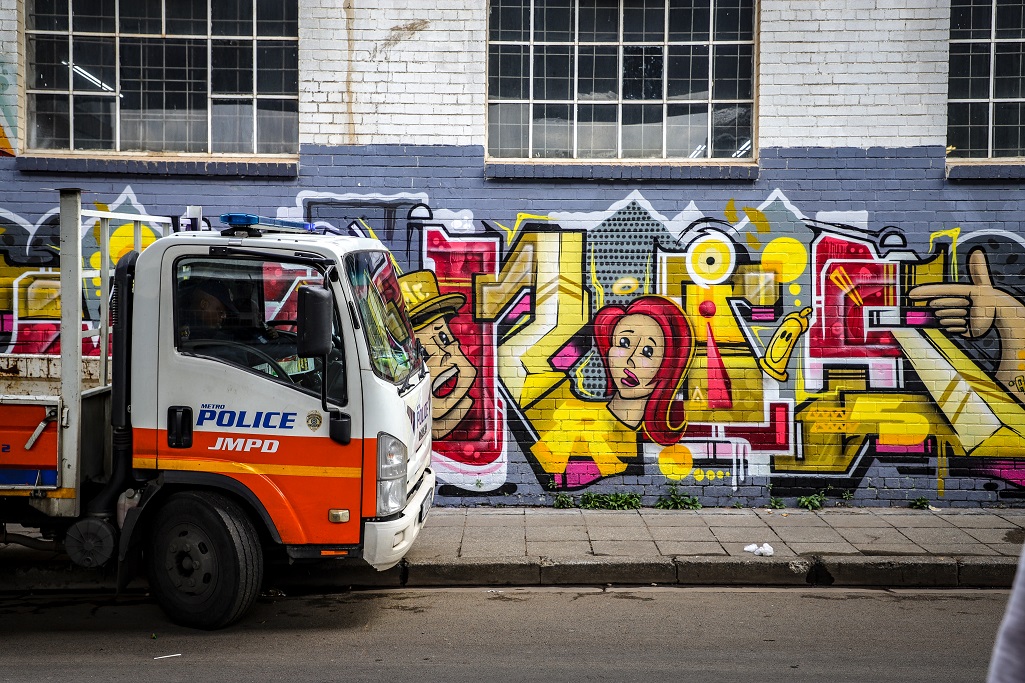*This article originally appeared in RVA Mag #34, on the streets now at all your favorite spots.
“The tension is there, but it is a good tension,” said street artist George “Mars” Kalapov as we toured Art Eye, the gallery he works from in downtown Johannesburg, South Africa.
“There is energy: not like a constrained energy, not constrained by authorities or governments. It is doing what people want to do, and having the common sense to remain human.”
To make his point, he held out his arm and encouraged me to take in the space. Unlike the more curated galleries of Washington D.C., Richmond, New York, and London, this gallery was an unrestrained salvo of artistry, technique, and medium; each piece represented a different version of the South African experience. It is precisely this experience which speaks to the tension that is fundamental to being South African: a tension that has still not found equilibrium 24 years after the end of apartheid.
Originally Bulgarian, Mars moved with his family to South Africa in 1995 when he was six. When his home country started transitioning from communist rule in 1990, it became marked by general strikes and an eventual collapse in government. By 1995, the country was in economic turmoil, brought about by a national program of privatization.
“Things were not going so great, but there was an agreement between governments about doctors being allowed to come into the country,” said Mars.
Spend enough time abroad, and it is easy to find the commonality linking certain kinds of street art together, regardless of their global geography. Some of this art originated with American countercultures in the 1980s and 90s, while others fused with local artistic traditions to form new styles unique to their own spaces. Mars is a product of this environment, coming into street art through the skate culture of Johannesburg in the early 2000s.
“Being out on the street skateboarding, and seeing what [older kids] thought street art and graffiti was, was a big part of it,” he said. “Back then, it was nothing like it was in the states. We had drips and drabs of information coming in.” He admitted that as kids, they just made it up as they went: “We didn’t know you were supposed to pick a name and have a tag.”


Before touring the gallery, I met Mars at a modish coffee shop in the Maboneng Precinct to journey through the city’s multiple layers of street art. Like all cities experiencing gentrification, this precinct was a blend of boutiques, loft spaces, and the creative class — all of which were set against poverty, crime, and corruption. It is a discernible city-scape which was instantly recognizable, and had all of the component parts needed for creativity to flourish; parts that were simultaneously cognizant of the past, but also future-facing.
We didn’t have to go far to see where these things collided, turning a corner onto a thoroughfare that was filled with street art, graffiti, bags of trash, street merchants, and the homeless. Mars’ art ran the length of the street, a mixture of traditional graffiti and murals, painted on the sides of garages and industrial warehouses. Before taking out my camera, I asked him about shooting in this part of the city. Violent crime in South Africa is a fact of life, and Johannesburg is no different. Robberies, assaults, home invasions, and murders rank the city fourth overall nationally in statistics from 2017.
“I’ve been robbed a few times,” said Mars. “I know people who have been hijacked, house robberies, so there is definitely proof of this happening. People are desperate.” To make his point, he shows me a can of pepper spray kept in the side pocket of his hoodie; even the most seasoned of street artists roll prepared.
“You have to be vigilant, but I don’t take any chances.”
The art on the street is not just vibrant and complex for the sake of the medium; it is also reflective and aware of the situation where it lives. While street art in the U.S. has become commercialized and a somewhat expected amenity of gentrified cities, the street art in Johannesburg still feels raw and untamed.
When I bring this up to Mars he simply says, “In terms of the art, you can pick and choose what aspects you want to bring attention to.” He went on to say that the best art is made during difficult times.
“A lot of [artists], myself included, see this as an opportunity.”
And it is not hard to see why artists in South Africa feel this way. Since the collapse of apartheid in 1994, the country has struggled to cope with the historical trauma of a system that used racial pseudoscience to maintain social and economic power. During apartheid, the population was divided into four categories: blacks, whites, coloureds, and Indians, which each came with various privilege and access. In Johannesburg, apartheid cut the city into 11 localities: seven for whites, four for blacks, all but ensuring that this system of segregation kept the black population in a perennial state of poverty — the legacy of which still exists today.
When Nelson Mandela was released from prison after 27 years, and eventually elected president in 1994, South Africa’s economy was in ruins. Years of international sanctions and economic isolation had wreaked havoc on the country’s finances. In the years following apartheid, however, South Africa’s economy rebounded, eventually becoming the economic power-house of sub-Saharan Africa. Yet corruption and mismanagement have plagued South Africa in the intervening years, and since 2011, almost 2.5 million people have slipped below the poverty line.


In Maboneng Precinct, there is a 131-foot mural of Mandela known as the “shadow boxer” by artist Ricky Lee Gordon, which soars upwards of ten stories. The mural is a imposing homage to a leader whose place in our universal consciousness is matched only by figures like Gandhi and Martin Luther King Jr. In his youth, Mandela trained as a boxer, once saying, “I did not enjoy the violence of boxing so much as the science of it… how one used a strategy to both attack and retreat.”
Johannesburg is a city that feels both offensive and defensive, constantly attacking and retreating; a city that is wild with strategies, hustle, and grind. The street art populating the city is a reflection of this constant tension, which has made Johannesburg a destination for artists globally. One might just as easily find a mural expressing solidarity with African women as one could find old school wild-style graffiti pieces. International artists like Shepard Fairey, Gaia, Pose, and Remed have all come to Johannesburg to tap into this creative tension — but it is local street artists like Mars, Bias, Tapz, Nomad, and Rasty who are on the street every day pushing the bounds of creativity.
Standing outside London Calling, a shuttered punk club now covered with street art and graffiti by artists like Mars, I asked the artist how the cops and city government cope with public art.
“It is a free-for-all,” he said. “Street art is the last thing on the authorities’ to-do list. Most of the community is not offended by graffiti.” Some residents in the city still don’t understand the art, but they support the idea of “adding some color to the community.”


Three Sisters is just such color. Completed by Mars in January of this year, the mural in the Maboneng Precinct tells the story of three black women, each spying on the street from different perspectives. Their faces are bold, graceful, and composed, each woman relaying their own story in a way that is suggestive of experiences only known to each other. When the mural dropped, each woman’s head was wrapped in Shweshwe, a traditional South African print that is identifiable by their intricate geometric patterns. Under the wraps are tags highlighting positive aspects of women’s empowerment, written in the 11 languages of South Africa.
“I wanted to paint something positive,” said Mars about Three Sisters. “It is kind of a protest piece, in that the head wrap has moved from being viewed as negative to something positive and unique to the community.”
While the Shweshwe fabric was eventually pulled off the mural by kids, the women’s empowerment and cultural experiences expressed by the mural endure through the tagged words hidden underneath.
“I knew the material would eventually fall off, revealing the words, which was also a play on time,” Mars said.
Sanele Manqele is a curator at Art Eye, where Mars has his studio. The space not only acts as a gallery, but also a residence space for forward-facing artists in South Africa. Touring the gallery with Manqele, it is clear why Johannesburg has gained such a global reputation for art, fashion, and design.
Asking her about the art scene’s recent growth against the backdrop of income inequality and poverty, she responded by saying that it came down to the story the art tells.


“There is a change in narrative,” Manqele said. “The narratives are becoming more localized to what’s happening right now, and that is necessary.”
Part of this is the political and social spaces in which people are now operating: not only are they aware of the community’s place in the conversation, but also how that conversation can connect artistically across cultures.
Acknowledging this intersection, Manqele articulated how this plays out in the arts scene they are curating.
“There is also experimentation with material and medium, like George’s [Mars’] graffiti,” she said, pointing out the understanding that art no longer has to be contained to “oil and canvas.”
With the growing acceptance of street art into the fine art lexicon, muralists like Mars in the U.S., Europe, and globally have found themselves in high demand. Yet it is the African energy and vibe that sets Johannesburg apart from its contemporaries.
We finished our interview looking out over the sprawling Johannesburg skyline from the roof of the gallery.
“Its unrestrained and un-curated, not just in the way people do street art, but in how they do business and entrepreneurship,” Mars said excitedly, before adding, “people are constantly thinking of creative ways to make it here.”
Before we went back inside, a late afternoon grey had settled over the city. Ellis Park Stadium, famous for South Africa’s Rugby World Cup win in 1994 (the same year Mandela was elected), stood silently in the foreground as the city came alive for the evening commute. From the roof, you could see the streets starting to stir in anticipation. It reminded me that the things we feel for cities are always contradictory: a place somewhere between love and hate, hope and despair.
In this, there is no city like Johannesburg.
“The people are doing what they want to do,” said Mars, before we parted ways. “One day they’ll clean Johannesburg up, but until then, I’m here.”
And that’s life in Jozi.



